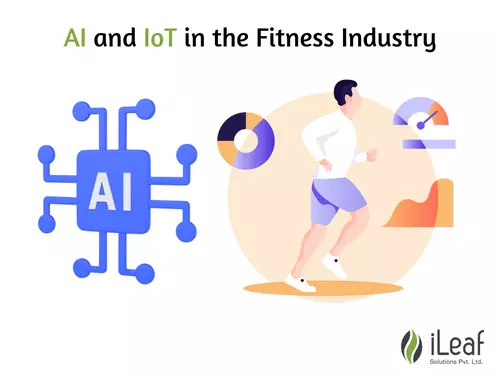The Transformative Power of AI and IoT in the Fitness Industry: Revolutionizing Health and Wellness

Introduction
Artificial Intelligence (AI) and the Internet of Things (IoT) have revolutionized the fitness industry, especially in the wake of the pandemic. With people being more health-conscious and confined to smaller spaces, the demand for fitness and wellness apps has surged. The integration of AI and IoT has transformed the way people approach fitness, offering personalized solutions tailored to individual needs and preferences.
AI is playing a significant role in modernizing the fitness and health industry. Fitness machines, wearables, gadgets, and mobile applications have been developed and enhanced based on user feedback and satisfaction. AI challenges traditional fitness notions by helping individuals systematize their daily habits. One notable application of AI is Human Pose Estimation Technology, which analyzes and detects the human body's entire structure, including skeleton modeling, contour modeling, and volume modeling using 3D body-scan techniques.
How is Artificial Intelligence (AI) changing the fitness world?
The future of AI in the fitness world looks promising. According to reputable reports, the fitness industry is projected to generate around $14.64 billion in revenue by 2027, with the number of users expected to reach 100.2 million by 2024. The increasing demand for AI-powered fitness applications is driving startups to focus on developing smarter and more user-friendly AI-based products.
What is the future of AI in the Fitness world?
AI-based applications have made significant contributions to managing dietary routines and meal planning. These applications assist users in achieving specific weight or fitness goals by offering suitable options and tracking their progress. They also regulate calorie intake and provide suggestions related to health, diet, and fitness.
Various opportunities are unlocked in the fitness world due to the evolution of IoT. Such platforms’ creation is made and decided by various developers and manufacturers catering to the best and perfect usage to the public. Various equipment related to fitness is now IoT-enabled. Many wearables and smartphones are embedded in IoT-based fitness applications. Presently smart bikes are being eminent in the stand-alone section of the market. Companies are focusing on providing IoT-efficient gym types of equipment with proper manuals making it user-friendly. A report published by the DTC showcased more than 125 million wearables units would be shipped worldwide.
Conclusion
To alleviate the burden of personal trainers' costs, AI-based personal trainer applications have been developed. These trainers mimic human trainers, providing guidance on exercises, postures, and recommending suitable lifestyle choices. AI-based wearables have also been introduced with smart designs to track various fitness metrics such as exercise duration, calories burned, distance walked, and heart rate. These wearables enable individuals to monitor their fitness levels effectively. AI-based fitness coaches are also available to guide users on their fitness journeys.
The IoT has also had a profound impact on the fitness world. It enables the interconnection of devices through the internet, bridging the gap between the digital and analog worlds. IoT has facilitated the creation of personalized gyms with minimal human intervention, maximizing efficiency and benefits.
The future of IoT in the fitness industry is filled with opportunities. Developers and manufacturers are working on creating platforms that offer the best user experience. IoT-enabled fitness equipment, wearables, and smartphones have already become prominent in the market. Smart bikes and IoT-efficient gym equipment are gaining traction. According to a report, more than 125 million wearable units are expected to be shipped worldwide.
IoT-based products are highly sought after due to their durability and data storage capabilities. These products can store accurate fitness data over an extended period, which can be used to track and improve individuals' fitness levels. Future IoT products aim to create tech-enabled fitness communities that require minimal personal interaction. They provide immersive workout sessions and allow for easy data sharing among connected devices. IoT platforms also enable individuals to compete with their own records, promoting better health and fitness. Smarter sensor technologies embedded in IoT products provide precise details, such as heart rate and calorie intake. Additionally, IoT products focus on safety in sporting activities, with innovations like smart helmets designed to protect against brain damage. Unified training platforms offer access to various resources during training sessions.
While AI and IoT have numerous advantages in the fitness world, they are not intended to replace human trainers entirely. Human trainers possess the ability to address individual shortcomings and guide trainees to perfect their technique. They also provide a higher level of interaction, resulting in a more personalized experience. Furthermore, accidents may be less likely to occur under the supervision of a human trainer compared to AI and IoT-based alternatives.
In conclusion, AI and IoT have transformed the fitness industry by providing personalized and cost-effective solutions. With the rapid pace of technological advancements, the future of AI and IoT in fitness looks promising. As long as these technologies continue to meet the evolving needs of consumers, the market is expected to experience significant growth. While AI and IoT can replace traditional gyms and trainers to some extent, human trainers still offer unique benefits, such as personalized guidance and a deeper understanding of human psychology. The immersive digital world empowered by AI and IoT will continue to shape the future of fitness.














